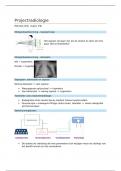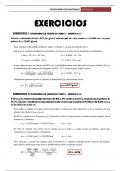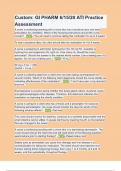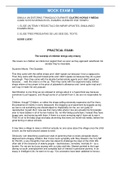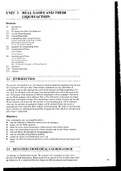Index
Learning objectives ................................................................................................................................. 3
Week 1 .................................................................................................................................................... 3
Lecture 1 – Challenges of Nutrition: Why do we need a more advanced nutritional science & Why do
we need nutrigenomics? ......................................................................................................................... 3
Food ..................................................................................................................................................... 3
What is healthy nutrition?................................................................................................................... 4
How to determine health? .................................................................................................................. 4
Lecture 2 – Genetics ................................................................................................................................ 6
GWAS – untargeted analyses .............................................................................................................. 8
Director-to-consumer (DTC) genetic testing ..................................................................................... 12
Week 2 .................................................................................................................................................. 13
Lecture 3 – Transcriptomics Analysis .................................................................................................... 13
Lecture 3 - Applications of Transcriptomics in Nutrigenomics Research; Mouse Model ..................... 20
Mouse models ................................................................................................................................... 20
Transcriptomics in mice nutrigenomics studies ................................................................................ 22
Lecture 4 – Application of Nutrigenomics in Human Dietary Intervention Studies .............................. 30
Example muscle biopsy – Acute study, cross-over design ................................................................ 34
Gene expression changes after high fat MUFA or SFA challenge – Effects on stress-related and
metabolic processes .......................................................................................................................... 38
Week 3 .................................................................................................................................................. 41
Lecture 5 – Background & applications of mass spectrometry in metabolomics research .................. 41
Lecture 5 – Metabolomics Biomarkers for Exposure and Disease/Health............................................ 49
Dietary Exposure Biomarkers ............................................................................................................ 49
Biomarkers of diet-related disease ................................................................................................... 55
Lecture 6 – Comprehensive phenotyping proteomics .......................................................................... 60
Proteomics......................................................................................................................................... 60
New Definition of Health ................................................................................................................... 62
Comprehensive Phenotyping to Measure Health Status .................................................................. 63
A Challenge Test to Magnify Health Status ....................................................................................... 66
Nutritional science 2.0....................................................................................................................... 68
Integration of Data ............................................................................................................................ 68
Lecture 6 – Transcriptomics and metabolomics in human skeletal muscle.......................................... 71
Lecture 7 – Epigenetic effects of nutrition ............................................................................................ 79
Week 4 .................................................................................................................................................. 98
1 Summary Applied Nutrigenomics
,Lecture 8 – Microbiome and Health...................................................................................................... 98
Lecture 8 – The effect of modulating the gut microbiota on non-alcoholic fatty liver disease .......... 113
Lecture 9 – From Nutrigenomics to Nutritional Science 2.0 to Personalised Nutrition? .................... 116
Consequences of Big Data ............................................................................................................... 116
Continuous Measuring of Health .................................................................................................... 118
Do It Yourself ................................................................................................................................... 119
N of 1 (Precision Medicine) ............................................................................................................. 120
Personalised Nutrition – The era after Nutritional Science 2.0?..................................................... 123
2 Summary Applied Nutrigenomics
,Learning objectives
After this course, the student is expected to:
Understand the basics of genetics, genomics and gene regulation with relation to diet;
Be able to read and understand literature of the field (molecular nutrition and nutrigenomics);
Have good understanding of genomics technologies such as transcriptomics, proteomics and
metabolomics and their applicability in nutrition research;
Have good understanding of the concepts of molecular nutrition research (signals and
signalling pathways, dietary sensors (nuclear receptors));
Have good understanding of the concepts of nutrigenomics (dietary signatures, identification
of very early biomarkers);
Have some basic understanding of epigenetics in relation to nutrition;
Have some understanding of the concepts of nutrigenetics (genetic susceptibility, SNPs,
polygenic (complex) diseases, GWAS ‘personalised’ diet);
Be able to do a basic analyses of genomics data derived from nutrition studies (microarrays,
bioinformatics, biostatistics, pathway reconstruction programs);
Be able to write and present a nutrigenomics project proposal (team of students);
Be able to design a study, using human or animal models, in which nutrigenomics is applied;
Have knowledge on the strengths and pitfalls of applying nutrigenomic tools.
Week 1
Lecture 1 – Challenges of Nutrition: Why do we need a more advanced
nutritional science & Why do we need nutrigenomics?
Key questions of the course
1. What is the problem? Why do we need nutrigenomics?
2. How to apply the nutrigenomic tools for nutrition?
3. What is the role of nutrition in the genotype-phenotype relationship?
4. What is health and how to measure and quantify the (metabolic) health status?
5. What is the impact of nutrigenomics for nutrition? What are the future applications?
Food
Human Nutrition – Challenges
Malnutrition; in non-western countries also double burden – coexistence of undernutrition
along with overweight and obesity.
Obese and malnourished: too little vitamins etc.
Worldwide more deaths by non-communicable diseases.
NCD such as obesity, CVD, diabetes, cancer; prevention by nutrition strategies not effective!
Why?
Pharma also enter pre-disease area with “safe” drugs (e.g. polypill)
Personalised diet: not everybody is the same, but the advice you get is on population basis, so
it might not even work for you.
Industry has no tradition in long term research.
Pharma wants fast results. A lot of investment in medicine, but not in nutrition.
Health claims (functional foods): most applications are not granted by EFSA.
Not easy to show health effects of nutrition.
3 Summary Applied Nutrigenomics
, What is healthy nutrition?
What do we know? Do we know the mechanisms behind functionality/health impact of foods?
Soybean (Edamame) affect 123 genes involved in prostate cancer.
Name of gene: p53
Function of gene: kills mutant cells
Long-term effect: a compound in soy increases activity of the p53 gene, helping to block
tumour formation
Broccoli boosts genes that protect against heart disease.
Name of gene: GST
Function of gene: Produces the body’s master antioxidant, glutathione
Long-term effect: the additional glutathione helps keep arteries healthy
Turmeric (Curry) suppresses genes that ratchet up inflammation.
Name of gene: Cox-2
Function of gene: makes inflammatory compounds
Long-term effect: could help ward off colon cancer and Alzheimer’s
Green tea helps silence genes that fuel breast cancer in some women.
Name of gene: HER-2
Function of gene: triggers growth signals in cells
Long-term effect: slows HER-2 signalling in aggressive breast tumours
Eat colour
Yellow: vitamin B6 and C, -carotene, lutein
Green: folic acid, lutein, vitamin C and K
Red: lycopene, lutein, vitamin C
White: flavonoids, potassium, quercetin, vitamin C
Orange: -carotene, flavonoids, lycopene, vitamin C
Netherlands
48% above 19 years overweight
13% above 19 years obese
How to determine health?
Obesity
Body Mass Index (BMI): a measure of an adult’s weight in relation to his or her height, specifically the
adult’s weight in kilograms divided by the square of his or her height in meters.
Fat is good in general, but when you have too much
of it or fat in the wrong places it is bad.
Too much fat subcutaneous fat storage
between organs and/or liver
Person can be skinny but have fat stored in
wrong places
It is in our genes?
An example from the type 2 diabetes components of
the Welcome Trust Case Control Consortium study.
The strongest associations are seen on chromosomes
10 (transcription factor 7-like 2; TCF7L2), 16 (fat mass
and obesity associated; FTO) and 6 (CDK5 regulatory
subunit associated protein 1-like 1; CDKAL1)
4 Summary Applied Nutrigenomics


